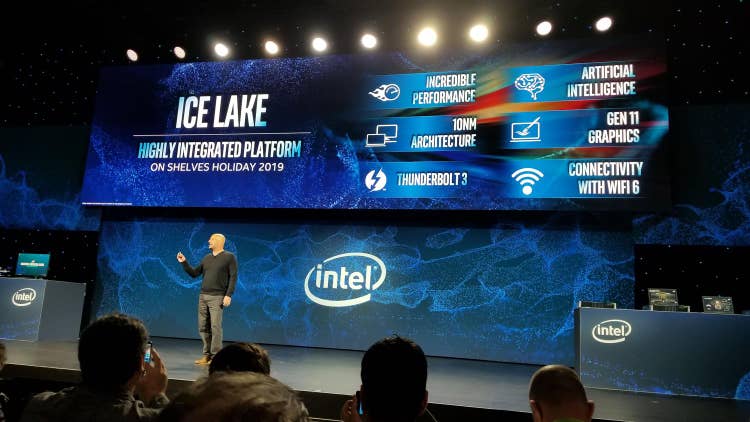Intel Reveals Long-Awaited Ice Lake 10nm CPUs At CES 2019

Intel on Monday revealed its long-awaited 10-nanometer client and server CPUs and a new hybrid CPU architecture at CES 2019 as the company faces increased competition from AMD.
The reveal of Ice Lake, Intel's 10nm CPU microarchitecture, comes after the Santa Clara, Calif.-based company faced multiple years of delays in releasing 10nm processors, an advancement in CPUs that is expected to bring performance and efficiency gains over Intel's current 12nm CPUs.
The first computers with Ice Lake will start hitting shelves by the end of the year, as the company has previously disclosed, and they will include new XPS systems from Dell.
[Related: Intel Vows Better Communication With Partners About CPU Shortage]
Gregory Bryant, senior vice president and general manager of Intel's Client Computing Group, showed off an Ice Lake chip during Intel's press conference after disclosing that the company is launching six new ninth-generation Core CPUs for desktops starting this month and new ninth-generation Core CPUs for laptops in the second quarter.
Ice Lake will be Intel's first processor to use Intel's new Sunny Cove microarchitecture and Gen11 integrated graphics, and natively support Thunderbolt 3 and Wi-Fi 6, Bryant said. It will also be the first client processor to use Intel's new DL Boost technology for accelerating inference-based workloads.
"All that is packed into this SOC [system on a chip], and, of course, because we're talking about mobile computing, you'll see it integrated into some wonderful thin and light two-in-one and convertible systems," Bryant said.
In a demonstration comparing Ice Lake to an eight-generation, 12nm Core CPU, the company showed that Ice Lake is able to complete an inference-based search for images 50 percent faster than the older chip.
"We can accelerate this kind of inference-based workload 50 percent, 70 percent, maybe even 2X," Bryant said.
Sam Burd, president of Dell's Client Solutions Group, came on stage to reveal an early build of an Ice Lake-based XPS laptop.
"We're excited about things like performance, battery life, graphics, connectivity and the enhancements you've made in those areas of being able to take them over to the system," Burd said.
Bryant also revealed a new hybrid CPU architecture called Lakefield that "integrates different CPU core architectures into a single product.”
Based on the company's Foveros 3D stacking technology that was revealed last month, Lakefield includes a 10nm Sunny Cove core for high performance and four Atom-based cores for low-power efficiency. The nature of the 3D stacking technology and its ability to integrate multiple chiplets on a single board means that partners create devices with form factors smaller than 11 inches, Bryant said.
"It means we can do smaller chips, smaller boards, more efficient, better designs," Bryant said. "It's going to unleash some great performance and great platform innovation in the industry and in even more innovative devices."
Later in the company's press conference, Navin Shenoy, executive vice president and general manager of Intel's Data Center Group, showed a demonstration of the company's Ice Lake 10nm server CPU running a simulation program.
The announcements were made as Intel has been reinventing itself into a data-centric company, leaving behind its brand as primarily a player in the PC business. The company's strategy has been paying off, with its data-centric businesses growing in the double digits, led by the Data Center Group, which grew to $6.1 billion in the third quarter.
At the same time, the company's PC business saw a resurgence in 2018, with Client Computing Group revenue growing 16 percent year-over-year to $10.2 billion in Q3. The growth, however, caught Intel off guard, leading to CPU shortages that continue to impact OEMs and channel partners. Intel has since invested an additional $1 billion in manufacturing capacity and announced that it would expand existing plants.
AMD, in the meantime, is slated to release its first 7nm EPYC CPU for servers at some point this year, with a 7nm Ryzen client CPU to follow sometime later. The company is expected to reveal more details about its 7nm CPUs — whose architecture is expected to be comparable to Intel's 10nm CPUs — during CEO Lisa Su's keynote at CES on Wednesday.